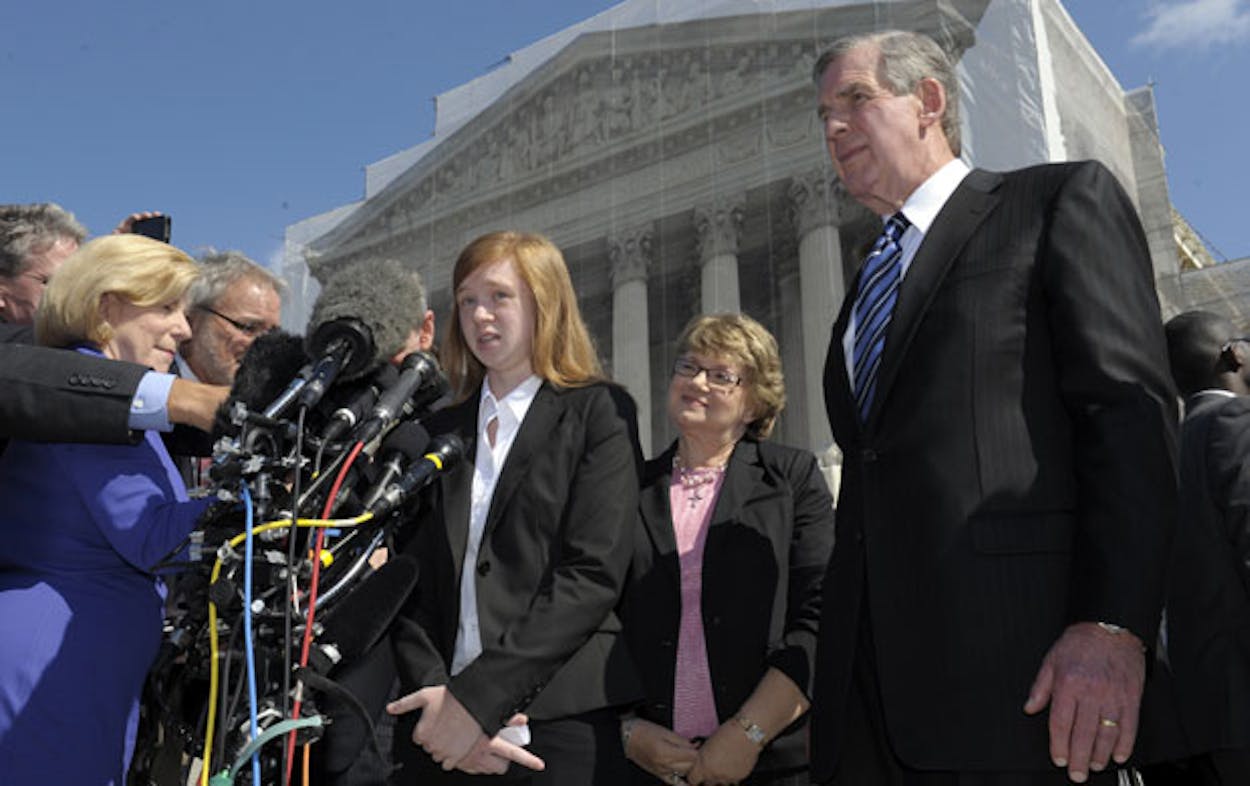For eighty minutes on Wednesday, the Supreme Court of the United States heard arguments in Fisher v. University of Texas at Austin, and the outcome of the case could forever reshape how affirmative action is used in college admissions.
Judging from the tenor of the arguments Wednesday, the Wall Street Journal‘s Jess Bravin predicted that the court “seemed likely to curb racial preferences in university admissions.”
First, some background: Abigail Fisher, a white graduate of Sugar Land’s Austin High School scored a 1180 out of 1600 on the SAT and had a 3.59 GPA which put her in the top twelve percent of her high school class, was denied entry to the University of Texas at Austin’s entering fall 2008 class. She went on to attend and graduate from Louisiana State University in Baton Rouge.
The court last weighed in on affirmative action in university admissions in 2003, when it ruled 5-4 in Grutter v. Bollinger that schools could use race as one factor among others in their admissions process, so long as quotas were not used. In her opinion, Justice Sandra Day O’Connor wrote that she believed the case would stand for 25 years. But now, nine years later, the composition of the court looks quite different, with O’Connor’s seat now occupied by Justice Samuel Alito, a staunch opponent of affirmative action. (Justice Elena Kagan recused herself from the case because of work she did on it as U.S. Solicitor General.)
In her dispatch from the court, Slate‘s Emily Bazelon highlighted the weakness in the arguments made by Bert Rein, Fisher’s lawyer:
Rein won’t concede that he wants the court to overrule Grutter. He also doesn’t agree when Justice Sonia Sotomayor says, “You just want us to gut it.” But that’s the vulnerability in Rein’s argument: It’s hard to differentiate the way in which UT takes race into account from the way the University of Michigan approaches it, something the court permitted nine years ago. Indeed, Justice Ruth Bader Ginsburg calls UT’s policy “more modest.” … The university admits up to 80 percent of its class by automatically admitting the top 10 percent of high school graduates across the state. The rest of the spots are allotted based on academic performance and an index of personal achievement that includes a host of attributes, from essays to leadership to community service to socioeconomic status and, yes, race. It’s individualized and holistic—the magic Grutter words. No quota.
At the New York Times, Adam Liptak noted that the justices’ questioning was “by turns caustic, exasperated and despairing” as they tried to pin down the university’s lawyers on the quota issue, with Chief Justice John G. Roberts repeating “two basic questions … in various forms at least a dozen times:
He wanted to know how much diversity was enough. And he wanted to know when colleges would be able to achieve an acceptable level of diversity without using racial preferences.
“What is the critical mass of African-Americans and Hispanics at the university that you are working toward?” Chief Justice Roberts asked a lawyer for the University of Texas at Austin. The chief justice never received a specific answer from the university’s lawyer or from one representing the federal government.
Their reluctance to answer illuminated a tension in the court’s precedents, which reject quotas but allow public universities to use race in admissions decisions as but one unquantifiable factor among many.
Had the lawyers responded to the chief justice by proposing a percentage goal, they would have run headlong into cases prohibiting quotas. In failing to offer a number, though, they left the court with very little to do in the face of precedents requiring judges to look closely whenever the government draws distinctions among people based on race.
At SCOTUSblog, Lyle Denniston forecast where the justices likely stood:
There is almost no doubt that the University of Texas’s affirmative action plan for admitting its freshman classes is in trouble with four Justices, but has at least qualified support from three others. The one most in doubt among the eight taking part: Justice Anthony M. Kennedy. He wanted to be convinced that the program does not use race at all costs, and it appeared that he was not.
The WSJ‘s Bravin described the mood of the court’s liberal justices:
Liberal justices seemed frustrated, if not angry, that so recent a ruling was being reconsidered.
Justice Stephen Breyer asked Bert Rein, Ms. Fisher’s lawyer, if he wanted the court to overrule the O’Connor opinion outright.
“Grutter said it would be good law for at least 25 years, and I know that time flies, but I think only nine of those years have passed,” he said. “Why overrule a case into which so much thought and effort went and so many people across the country have depended on?”
In a press conference on the steps of the court after the arguments, Fisher said “[m]y parents always taught me that it is wrong to discriminate. I hope the Supreme Court will decide that all future University of Texas applicants will compete without their race or ethnicity used in the school’s admissions process.”
The Baton Rouge Advocate‘s Jordan Blum pointed out that if the high court splits 4-4, the ruling of the U.S. Court of Appeals for the Fifth Circuit, which came down in favor of UT, will stand.
- More About:
- Politics & Policy
- Supreme Court
- Affirmative Action







